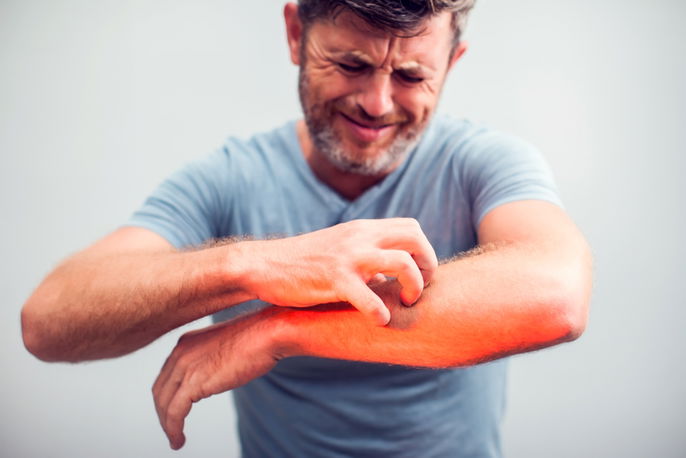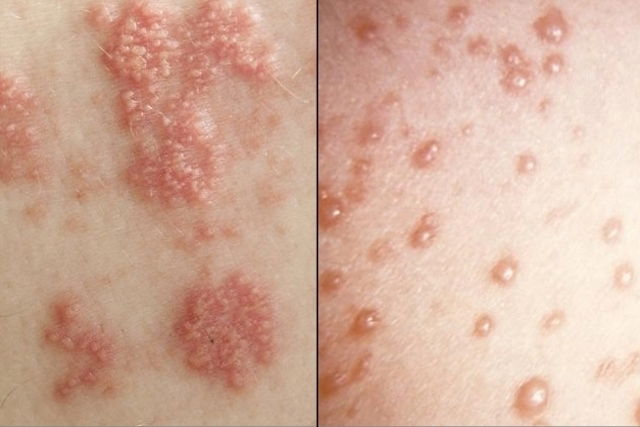What is it:
Shingles is a skin infection that occurs in people who have had chickenpox at some point in their life, and are either going through a very stressful period in their life or have a weakened immune system (e.g. from an infection like a cold or flu virus). It is medically referred to as herpes zoster.
Following a chickenpox infection, the varicella-zoster virus can remain dormant in the body without causing any signs or symptoms. However, this same virus can be reactivated at a later time by a significant stimulus, resulting in shingles.
Common shingles symptoms include water blisters, that normally appear along the chest or back, increased pain in the affected areas and increased sensitivity to touch. When early signs appear, prompt medical consultation is recommended so that treatment can be initiated.

Main symptoms
In an early stage, shingles can be identified by the development of fluid-filled blisters on only one side of the chest or the back. The affected skin will also be painful and sensitive to touch.
Additional symptoms of shingles can include:
- Itching in the affected areas;
- Redness and swelling of the skin;
- General malaise;
- Headache and fever;
- Small lesions or scabs on the skin after the blisters have dried.
Blisters will appear within 3 days, and once ruptured, they will exude a transparent fluid, which can increase the risk of developing a subsequent bacterial infection.
Shingles blisters will last for an average of 10 days, but in some cases, they can last for up to 21 days. Therefore, it is important to seek medical attention promptly so that proper treatment can be initiated.
What causes shingles
After a chickenpox infection, which typically occurs in childhood, the same virus (varicella-zoster virus) can remain dormant in the body without causing symptoms. However, the virus can still be reactivated, specially if the immune system becomes weakened, resulting in shingles instead of chickenpox, as chickenpox rarely reoccurs in people more than once in their lives.
Although it is rare, shingles can emerge in kids and babies that have had mild cases of chickenpox with minor symptoms. It is also rare for shingles to spread to other parts of the body; this is usually more frequent in people with a history of AIDS or chemotherapy.
How it spreads
It is not possible to transmitted a shingles infection to a person who has been infected with chickenpox in the past. However, a person with an active shingles infection can pass on the virus to someone who has not had chickenpox, and they will normally develop a chickenpox infection. In those cases, after the initial chickenpox infection, it is possible to develop shingles later in life.

Treatment options
Treatment for shingles should be monitored by a dermatologist or a G.P, who will typically prescribe 5 to 10 days of antiviral medication, such as Acyclovir (Zovirax), Fancyclovir (Penvir) or Valacyclovir (Valtrex).
The doctor may also prescribe anti-inflammatory medication (like Ibuprofen) or corticosteroid creams (like Betamethasone or Flordroxycortide), which will help alleviate pain and skin irritation.
Home remedies for shingles
When treating shingles, it is also possible to use some home remedies to speed up healing, however these do not replace treatment that is prescribed by the doctor.
Some great available options are burdock leaf tea or blackberry leaf tea. See the instructions below on how to make these teas:
Ingredients
- 1 tablespoon of thinly chopped burdock or blackberry leaves;
- 1 cup of boiling water.
Preparation
Put the leaves into the cup of boiling water, cover it and let it seat for 5 to 10 minutes. Allow the tea to cool and run it through a strainer. Apply it directly to the lesion areas with a clean gauze. This can be done once or twice per day, using fresh gauze with each application.






























